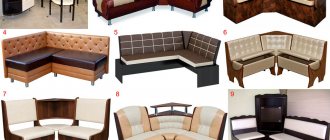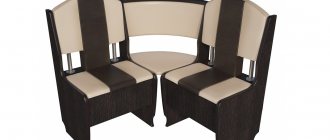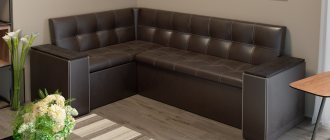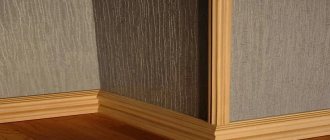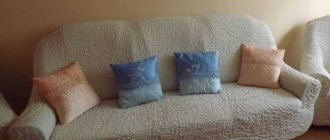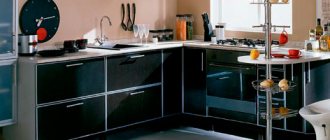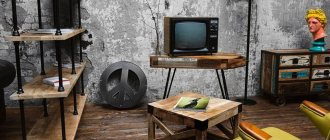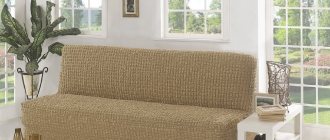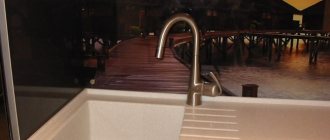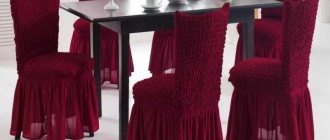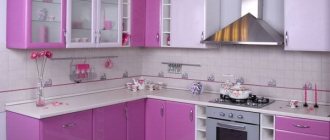How to sew a cover for a kitchen corner with your own hands
Statistics show that housewives spend half of their daytime in the kitchen. Cooking and setting the table is only a small part of the work process.
When everyone is happy and full, it's time to clean up. Stains are a popular consequence of cooking. If they do not scare the kitchen set and countertop, then the upholstered furniture requires extremely careful care.
The dining area with the kitchen corner is at risk, but there is salvation. A kitchen corner cover will be the best shield that protects furniture from unwanted dirt.
How to sew a cover yourself?
This is quite easy to do if you have basic sewing skills. What you will need to sew the simplest cover:
- upholstery fabric;
- material for pattern;
- several zippers or large buttons;
- a piece of soap or chalk;
- special pins for furniture.
When choosing fabric for sewing a cover, you should choose an option that is both pleasing to the eye and practical. It should be easy to clean, and ideally be dirt-repellent. As a fabric for sewing a cover, you can choose a piece of flock, tapestry or velor. The cost of these materials is low, and the variety of textures and colors is impressive. You can find an option for every taste.
In order to make a pattern, you need to take the material for its manufacture, cover the seat, back or one of the armrests, and straighten it out evenly. Using chalk or soap, mark all the folds of the part. After this, you need to carefully baste the pattern fabric. In a similar way, you need to cut out all the details of the future product. After the parts are cut out, they need to be laid out on the fabric from which you plan to sew the cover, and, leaving seam allowances, cut the product.
Next, the parts are connected to each other with strong seams, either manually or using a sewing machine. Places where you plan to sew fasteners must be left unsewn. If you want the product to be fastened with buttons, sew them on and cut the appropriate number of loops on the opposite side. If the cover will be fastened with one or more zippers, sew them in.
You can cut the cover without fasteners, then it will be pulled on in one whole-cut (or all-sewn) piece and removed in the same way. The pattern for such a product is similar to the patterns for chair covers; it is also not difficult to make with your own hands. If your kitchen corner has a bizarre back shape - it is convex or concave, then making a cover will not be so simple. Before you start sewing, you will need to cover this part, creating an absolutely flat surface, and only then start sewing.
To prevent the cover from “fidgeting” on the seat, it needs to be secured. This is done using ties (similar to bows that secure similar products on chairs) or using a separately sewn strip of fabric that is secured with furniture pins or Velcro. The strip should be as long as the circumference of the corner (back) at the top edge.
Features of choice
Since the corners can be of completely different sizes and configurations, it is best to sew the most suitable option yourself, because buying a Euro cover without armrests or ordering it from a designer can be much more expensive. And if you sew several copies, the furnishings in the kitchen can be changed by simply changing the cover and the rest of the textiles - towels, curtains, potholders and tablecloths.
Purpose of bedspreads
We save space: a kitchen corner for a small kitchen, photo, manufacturing technology
Many will find it inconvenient to cover a corner with a cape, especially in the kitchen. In a small space, additional details seem unnecessary. However, the case is guaranteed to preserve the appearance of the products. Neat furniture is the first sign of cleanliness and order in the house.
The cover is a mobile device that is easy to take off and put on. Removable models will protect sofas, chairs, and armchairs from grease and soot. Dirt can cause inconvenience because the upholstery is extremely difficult to wash. With a cape such problems will not arise. You can take it off and throw it in the washing machine in no time.
In addition to its usual purpose, a furniture cover refreshes the interior. He will update the old kitchen corner and transform the room.
Range
The range of covers for upholstered furniture today is represented by the following options:
Eurocase
Covers of this type can be used to cover and protect furniture of any design; they are convenient to take off and put on. Such products are universal and suitable even for sofas with a shelf or bar. Used for sofas with a right or left projection.
Capes
This type of cover is not just an ordinary piece of fabric that can be placed on the sofa and then endlessly adjusted. Capes are also divided into several types:
- sets that are designed for each individual component of the sofa in the form of bedspreads,
- covers that follow the geometry of the sofa,
- sets, each element of which covers one part of the sofa.
With elastic band
Covers of this type are stretchable products; they must be well straightened before putting them on furniture. Otherwise, such products are very convenient to use, look extremely aesthetically pleasing and, due to their versatility, are suitable for sofas that have a protrusion on both the left and right and are essentially dimensionless.
Covers for the kitchen corner (33 photos): removable models
How to sew chair covers with your own hands (135+ photos)
The first type of style fits tightly and fits like a glove. This is more of a model for every day, which is made from practical fabric and is resistant to moisture and stains.
This is the so-called working version, which is used in full all the time and is removed only on special occasions in order to demonstrate the beauty of the furniture. Sewing such a cover with your own hands without the skills is quite problematic.
But if you order it to be made by a specialist, then, if it is sewn with high quality, it will look stylish and expensive.
The decorative cover has a completely different purpose. It is put on furniture when a large feast is expected and the owners are afraid that guests may inadvertently stain the upholstery of the upholstered furniture.
As for the style, it can be loose tailoring or even just a cape or blanket like those used to cover furniture during repairs or before a long departure. You can sew such covers yourself.
There are also case options that combine the functions of both types. This is a case that is used every day, but made of beautiful fabric.
Advantages and disadvantages of homemade covers
There are many positive aspects to making chair covers with your own hands:
- Economical option. Making a cape yourself is not such a difficult task. And if you approach it responsibly, having prepared the necessary materials and studied the instructions for sewing or knitting, then it is also not time-consuming. Making a cover yourself will cost much less than completely restoring and reupholstering furniture, as well as purchasing ready-made covers in a store.
- Design solutions. New chair covers are a great option if you want to refresh a boring interior. In addition, self-production will allow you to bring the product to life in any style.
- Practicality. Capes and covers protect furniture from many external factors, such as sunlight, moisture, steam, and various contaminants.
Among the existing disadvantages of capes and covers, we can highlight: the need for regular washing or cleaning, getting rid of dust. If there are animals in the house, then it is possible that the surface of the covers will periodically be exposed to the negative effects of claws and teeth. Over time, products may require restoration.
Colors
Features of loft-style furniture and self-production
In addition to the texture of the material, the choice of fabric colors is very important. If you plan to place furniture in a bright room, then it is better to choose a cover in pastel shades. A room decorated in these colors is perfect for relaxation.
If you need to make the decor more luxurious, combinations of classic contrasting shades such as white and chocolate will help. For large sofas, you should not buy fabrics with small patterns, and too bright an ornament on the color of the cover will be annoying. Also, if you have to choose from several shades, it is worth turning to the psychological aspects of working with color, because the same color can have a completely different effect on the psyche, being several shades lighter or darker.
The selection of a shade of orange must be approached with special care. Experts do not recommend using orange as the main color when decorating a room or for large details in a room, because it has a stimulating effect on the nervous system. Slightly whitened shades of orange or slightly darker than its pure color will look more advantageous.
A shade of green close to pastel evokes not always appropriate associations with hospitals and schools, however, it has a calming effect on the nervous system and promotes thought processes. Dark shades of color have a similar effect. The difficulty in using dark green in room decor elements is that it is very difficult to choose suitable furniture colors for it.
The most optimal and multifaceted color that can formally be classified as green is light green. This is a very interesting shade, which includes the properties of the above-mentioned range and warm colors. Unlike light green, light green does not set you up for passive reflection, but for active knowledge of the world around you.
Light blue, blue or purple are suitable for the product if the sofa is the only (or almost the only) piece of furniture in the room. And if blue fabrics can still be safely used, then with an abundance of purple or blue you should be more careful, since these colors, as a rule, have a depressing effect and contribute to depression.
White color, according to experts, is relatively neutral in its effect on the psyche. Its indisputable advantage is that a sofa with a cover of this color will become an ideal “base” for further decoration of the room, and even the sofa itself. By adding pillows in bright colors, the furniture will be much more pleasing to the eye.
Black and gray colors, as well as blue and purple, should be used very sparingly, since the use of fabrics of these shades for accessories or just for sewing a cover can give the room a more stylish and strict look, or can make the room mournful and “oppressive.” The choice of brown color also needs to be approached carefully.
Properties of materials for sewing covers
The second important point after choosing a cover model is the fabric from which it will be sewn. The appearance of the product, its service life and comfort of use depend on the material.
Types of fabrics that are suitable for covers
Most often, the following types of fabric are used for covers.
| Matter | Description |
| Flock | Soft and durable fabric has excellent protective properties, does not fade in the sun and is suitable for corner furniture in the living room. |
| Teflon flock | The addition of Teflon gives the fabric additional strength; the fabric is resistant to animal claws, as well as many types of stains. |
| Velours | The fabric is similar to velvet, does not cause allergic reactions, and is easy to clean and wash. If there are animals in the house, you should not choose velor, since you will have to constantly remove hair from the surface. |
| Cotton | One of the most environmentally friendly materials, the disadvantages include fragility, unless synthetic fibers are included in the composition, as well as shrinkage of the fabric after washing. |
| Microfiber | European covers for corner sofas are made from it. Quite durable fabric, especially if Teflon is included in the composition. Excellent to clean and wash. |
| Chenille | The material feels like plush, the acrylic in its composition gives it lightness. |
| Jacquard | Strong and durable material, resistant to abrasion and deformation. The composition contains elastane, cotton and polyester. Due to its special strength, you can choose it for apartments with animals. |
| Nubuck | Nubuck upholstery with Teflon impregnation is pleasant to the touch; covers made from it will make the living room respectable and cozy. The material requires daily care. |
Flock
Furniture microfiber
Jacquard assortment
Quilted fabric for covers
A quilted cape will make the room feel homely. If you sew a cover with your own hands, you need to buy a little more fabric for the front and back sides, since the stitching will reduce the size of the product. A thin layer of padding polyester will help maintain the shape of the model.
Quilted models also include a cover made using the patchwork technique. To create an unusual decorative effect, experienced craftswomen spend more than one day selecting materials and composing a pattern.
Types of textiles for the production of covers for corner models
Manufacturers sew covers from several types of fabrics (there are about ten of them). But the most in demand are seven types of products made from natural and synthetic fibers in different colors.
Jacquard
Made from 80% cotton (elastane and polyester are also added), the material has a high degree of stretch and excellent durability. The claws of pets will not cause much harm to such upholstery. This is facilitated by a very dense weave of threads. A three-dimensional image gives the textile an impressive appearance.
Jacquard
Shinil
This light but dense fabric, slightly reminiscent of plush material, greatly decorates the interior through the use of interesting patterns. The material is made from acrylic (the main type of thread), cotton and other fibers. The soft fleecy surface is dirt-repellent.
Shinil
Pleated
Textiles made from cotton and polyester look simple and a little rough, but this textured coating looks good on upholstered furniture. In addition, it is highly resistant to mechanical damage.
Pleated
Jersey
The fabric is made from elastane and polyester. It is medium-dense, soft, pleasant to the touch, has a smooth texture and has good wear resistance.
Jersey
Microfiber
The material stretches very well and tightly fits sofas of any configuration, giving upholstered furniture a luxurious look. The fabric is soft and cozy.
Microfiber
Eco leather
Such a covering would be appropriate at home, but eco-leather covers are especially in demand in office premises, as they have excellent anti-vandal qualities.
Eco leather
Flame retardant fabric
Those who care about home safety will appreciate covers that have the ability to prevent the spread of flames. The composition includes kanekalon fibers (75%) and polyester. The colors of the cases are mostly neutral.
Furniture fabric fire resistant
Not only are there quite a lot of fabric options used when sewing covers. The color palette of materials allows you to choose the optimal solution for any interior.
Fireproof fabric
Various types of coatings can be used to decorate furniture in interiors of various styles.
- Jacquard is perfect for covering furniture in classic settings.
- In rooms decorated in Art Nouveau style, it is appropriate to use covers from the Shinil series.
- The not very conspicuous pattern of pleated fabrics can fit into any interior. But such cases will look especially harmonious in modern designs: fusion, hi-tech, as well as in Scandinavian style.
Main varieties
The first type of style fits tightly and fits like a glove. This is more of a model for every day, which is made from practical fabric and is resistant to moisture and stains. This is the so-called working version, which is used in full all the time and is removed only on special occasions in order to demonstrate the beauty of the furniture. Sewing such a cover with your own hands without the skills is quite problematic. But if you order it to be made by a specialist, then, if it is sewn with high quality, it will look stylish and expensive.
The decorative cover has a completely different purpose. It is put on furniture when a large feast is expected and the owners are afraid that guests may inadvertently stain the upholstery of the upholstered furniture. As for the style, it can be loose tailoring or even just a cape or blanket like those used to cover furniture during repairs or before a long departure. You can sew such covers yourself.
In what style should I make a cover or cape?
Before you start making something with your own hands, you need to decide on the style, materials and manufacturing technique. Some people will like knitted seat covers, while others will prefer a long cover decorated with ribbons, fringe, lace or tassels. In any case, the decor should match the interior of the kitchen as a whole.
- Classic. In classic kitchen interiors, you can use different options. For example, a straight back cover that follows the shape of a chair, with a long or short seat cover.
- Country. For a rustic interior, natural fabrics with an unobtrusive floral pattern, checkered patterns or plain ones in light colors are suitable. You can decorate the cape with a lush patchwork arrangement.
- Provence. The Provencal style is characterized by light and gentle images, close to nature and quiet country life. Therefore, covers for stools should be made of natural light fabrics, decorated with folds, frills, cords, ribbons, etc.
You can also make with your own hands not only furniture covers that are used daily, but also holiday options. They are suitable for decorating the kitchen interior on special occasions: birthdays, New Year, Christmas and other significant events.
We sew a simple sofa cover with our own hands
If you know how to sew at least a little, you can sew a sofa cover with your own hands. You don't even need a pattern for this. It would be useful to make such a case for novice crafters to develop their skills.
Sewing a sofa cover with your own hands
Step 1
Before sewing a cover for a sofa, you must first measure it. Divide the sofa into sections. Even if the upholstered furniture has non-standard dimensions, cut all parts in a rectangular shape.
Measure the seat, backrest, two armrests and two pads for the front of the armrests. You will end up with six rectangular templates.
Step 2
Remember to measure each part of the sofa as a rectangle, regardless of its actual shape.
Write down your measurements and add 7.5cm to all sides of each rectangle to ensure adequate seam allowances.
Step 3
Armrest insert, one for each
Draw an exact drawing of all the rectangles on paper, adding an extra 7.5 cm. Cut them out.
You can use either light upholstery material (137-152 cm wide) or a couple of large pieces.
Step 4
Wrong side out
Pre-treat your chosen fabric. Wash it in cold water and dry it. Place on a flat surface.
Using your measurements, cut out 6 rectangular pieces. Start from the back. Once all the pieces are cut out, place them wrong side down on the appropriate sections of furniture.
Use pins to pin pieces of fabric to the furniture to prevent them from slipping.
Step 5
Pin the armrest insert
Pin the pieces of fabric together; then sweep them away without removing them. For basting, use a thread of a contrasting color.
In order for the product to follow the shape of the furniture, you need to take into account all the angles and bends when connecting pieces of material with pins.
Trim excess fabric
Remove the pinned fabric from the sofa. Sew all seams using a sewing machine at a distance of 2.5 cm from the basting line. Turn right side out and place on the sofa.
Look carefully at the places where the cover may not fit well, and make additional marks in these places. Turn inside out again. Sew the cover again, taking into account the additional changes made. Trim any excess fabric.
Step 7
Remove running stitches. Turn the product right side out and place it on the furniture. Fold the edges, pin, and make a running stitch.
Now remove and machine stitch the edges. Remove the basting and you're done.
Now, having learned how to sew such a cover, you can easily sew chair covers. I wish you success!
Adviсe
• When choosing material, pay attention to leftovers, this will help you save a lot. Stores usually offer big discounts on leftovers.
Just make sure you have enough of them.
• When purchasing material, it is better to buy an additional 180 cm just in case. If you have extra fabric left, you can sew pillows from it.
• If you have never sewn before, keep in mind that you can first make a trial version of muslin before using upholstery material.
• Always make running stitches first. If you need to make any changes, a running stitch is the solution to the problem.
• If you feel that the product is too loose, you can easily fix it. Cut a wooden rod or narrow strip of PVC as long as the back or side. Place the rod between the backrest and the seat, or between the seat and the armrests, on top of the cover. This method works great.
Cut out new upholstery
The well-known proverb about the need to measure seven times and only then cut in the case of reupholstering a soft corner for the kitchen is more appropriate than ever. Moreover, you need to know some nuances on how to correctly measure and cut new upholstery. So, when working, follow these steps:
- Remove the old upholstery from the corner.
- Using a tape measure or measuring tape, measure all the parameters of the cuts - the width and height of the pieces of fabric. Make all measurements based on the maximum bend length.
- After the measurements have been taken and new material has been purchased, proceed directly to cutting. To do this, lay out the fabric in one layer, and place pieces of old upholstery on top of it. Trace the contours of the cuts on the new fabric with special chalk - this strip will be easily removed when wiping the fabric with a slightly damp cloth.
Important! It is also advisable to leave approximately 5 cm on each side for the hem of the fabric.
- If you have a plain fabric with a clearly defined pattern, then make sure that the pieces that will be located next to each other have a consistent pattern. Also, during the cutting process, determine the so-called share thread - the tension thread of the fabric. Make sure that in all areas of the material such a thread is located in the same direction, for example, everywhere in height or width.
Important! Incorrect calculation of fabric can reduce all the work to nothing and result in unnecessary expenses. Therefore, a novice craftsman needs to make the most accurate calculation of the material as follows: take any unnecessary old fabric on which to lay out pieces of old upholstery. After this, measure how long and wide you need a piece of new fabric.
Question of price
Today, manufacturers offer a huge range of European covers, the cost of which can vary greatly. The price of the product is affected by:
- material of manufacture;
- sofa dimensions;
- complexity of cutting and sewing.
The simplest and most budget-friendly models are covers for sofas without armrests. Products for corner furniture are considered the most expensive. Such options can be decorated with frills and ruffles. The greater the number of such decorations, the higher the cost of the product. On average, the cost increases by 1,500 rubles. The highest cost is for jacquard covers.
The cost breakdown is as follows:
- double rooms - from 6,000 rubles;
- full-size standard - from 7,500 rubles;
- corner - from 11,000 to 20,000 rubles.
When purchasing, it is recommended to inspect the product for defects and defects, and read the quality certificate for the product. At the moment, the undoubted leader in the production of European covers is still the Beelastico brand.
We make a cape for the corner
The cape is a simplified version of a replaceable cover for kitchen furniture. Products are manufactured in several styles and models. They can be roughly divided into covers that completely cover the sofa and partially protect the furniture from rubbing.
A blanket that partially covers the kitchen corner does not require much effort to create or special sewing experience. It is enough to measure the width and height of the back, seat and armrests of the kitchen corner, then transfer the measurements to the fabric.
This accessory is created on the principle of a transformer. Each part of the corner cape is cut out separately and sewn into one piece only at the folds.
Each part is secured with adhesive tape or ties.
Any tailoring begins with measurements. Then a pattern is made and then transferred to the upholstery fabric. The product must be basted and tried on.
When choosing the option of sewing a cover, you need to take into account the style and interior of the room, the possibility of combining the cover with other kitchen furniture. Bulky fabric that hangs down to the floor and large decorative elements look out of place in a compact and small room.
The bench should create a feeling of coziness and comfort, so it is better to give preference to practical covers that partially cover the corner.
Stages of sewing a cover
Conventionally, the work of sewing replaceable textiles for the kitchen corner is divided into several stages:
- Selecting a style and creating a product pattern. Apply muslin to each individual part of the sofa and use chalk to trace the outlines. The back, armrests and seat must be carefully measured and their dimensions transferred to a special fabric.
- Sew the patterns together. Try the rough product on the kitchen corner several times and eliminate any possible defects. Much attention should be paid to the places of folds and hems. This step-by-step instruction will help you create a pattern for a cover of any model.
- Once the test piece is on the bench, cut the muslin into pieces and pin them to the upholstery fabric. Then cut out the fabric elements for the cover. Connect the parts together with dense threads. At this stage, zippers and fasteners are sewn in.
- The finished cover for the kitchen corner is being tried on.
- The product is being decorated.
If you follow the recommendations, even a person without experience can create a blanket for a corner.
What is a Eurocase
Eurocover is a special design designed to cover the external surface of furniture. Initially, only Italian products were called this way. The invention turned out to be very successful and quickly spread throughout the world. Today, this term is used to describe a large category of products intended for upholstered furniture.
The classic model of the Euro-case is an expensive item, since it is manufactured using a special material made using the “beelastico” technology. Special elastic threads are woven into the fabric, due to which the sofa cover can stretch to the desired size.
Manufacturers today use various technologies to give covers elasticity. Such products are used for traditional corner sofas, kitchen corners, and furniture of non-standard shapes and sizes. The colors and textures of European covers are quite varied, both in terms of the texture of the material and in terms of color solutions.
Advantages of self-upholstery
For a novice home craftsman, reupholstering kitchen corners is not difficult. Simple design, availability of materials, simple manipulations simplify the process. Advantages of independent work:
- saving money without losing quality;
- acquiring a new skill (after wear and tear, restoration will be needed again);
- You can carry out repairs at any time;
- the opportunity to choose the materials yourself.
Companies offer calling a specialist to your home, taking measurements or removing furniture for subsequent restoration. All this is not cheap, and it takes a lot of time. Therefore, independence is more appropriate here.
A high-quality result cannot be achieved without disassembly, so you will have to spend time disassembling the structure and removing elements. This will allow you to change the coating without damaging other surfaces.
The owner independently assesses the condition of the structure. To strengthen it you will need fittings and suitable fasteners. To update the appearance of wooden panels, you will have to resort to using paint and varnish. To facilitate the process, tools and materials are prepared in advance.
Saving money without losing quality
Learning a new skill
You can make repairs at any time
Possibility to choose your own materials
Kinds
For sofas of different models, double, triple and corner covers are produced. The modification of the covers is determined in accordance with the measurements of the structure along the length of the back, namely:
- if the length of the back of the sofa is 1200–1600 mm, choose a double euro-cover;
- if the back length is 1600–2450 mm, then purchase a three-seater model;
- for corner furniture, choose a product with a size of 3800–5500 mm.
In addition to these options, covers are produced for sofas and armchairs without armrests or for custom-made furniture. Corner models come in right- and left-handed versions. This feature must be taken into account when choosing a product.
With ledge
is engaged in the production of textiles for furniture. For models with a protrusion on the right, the Anthracite model from Turkish manufacturers is suitable. It has the following features:
- The kit includes a case with clamps;
- the product is packed in a PVC bag with a zipper;
- the stretchability of the product along the back, taking into account the armrests, is up to 450 cm;
- composition: polyester – 60% and cotton – 40%;
- armrests have a height of 35–45 cm;
- The width of the seat on the long side is 200–280 cm, and on the short side – 80–170 cm.
To decide which case to choose for a corner sofa with a ledge on the right, you need to measure the length of the ledge and the furniture. Manufacturers produce universal covers for corner models with a protrusion on the right, so they will fit options with a right shelf in the corner.
With armrests
On sale you can find products that fit sofas with and without armrests. When choosing, take into account that the European cover for a corner sofa without armrests differs slightly from models with armrests. According to the manufacturers, the stretchability of the material is so great that it allows you to stretch it onto the sofa with a smaller cover. For a classic corner sofa with armrests, a cover from the Microfiber and Vista collections is perfect. The stretch of the fabric along the back, not taking into account the armrests, is 380–530 cm.
Without armrests
The cover for the model without armrests is different in shape from the usual “standard” covers. The “Modern Champagne” case from the Italian manufacturer will fit perfectly into a classic interior thanks to the pleasant color of the coating, without the presence of decorative elements. This wear-resistant material is perfect for long-term use. The material consists of cotton and polyester. The stretchability of the product is 150–220 cm. Covers for sofas without armrests are suitable for furniture of standard dimensions and shape.
With elastic band
There are textile options with elastic. These products cover the furniture completely or partially. An elastic cover for La Pastel corner sofas made in Russia will reliably protect the furniture from dirt and scratches. The product is 100% cotton. The stretch of the cover is 355–375 cm, there are frills at the bottom. The product has a reasonable price, but manufacturers produce the model only in 2 colors.
Dimensions
Euro covers are variable in size. Due to the fact that the fabric stretches, the same product can fit furniture of different sizes. However, there are still boundaries. For example, large products are suitable for corner sofas measuring from 300 to 490 cm (including armrests). If desired, you can find a larger and more compact option.
Some manufacturers indicate exact parameters. For example, a product can be designed for a sofa with an armrest height of 30-40 cm, a seat width of 210-250 cm and 140-180 cm (long and short sides, respectively) and a seat depth of 70-85 cm. If fabric It doesn’t stretch at all, the parameters can be even more specific.
Types and sizes of European covers for upholstered furniture
To choose a suitable model, it is enough to know the length of the back of the sofa. Depending on the size and model of the sofa, covers can be of three types:
- Double: backrest width from 1.2 to 1.6 meters;
- Triple: backrest width from 1.6 to 2.5 meters;
- Corner: the size of the backrest can be from 3.8 to 5.5 meters. There are models that only fit left-handed or right-handed lugs.
Universal European covers for non-standard sofas
Sometimes sewing workshops offer to make European covers for non-standard sofas. These can be sofas with high backs or armrests.
Covers for upholstered furniture without armrests
Sofas without armrests are a separate issue for manufacturers of European covers. What colors and styles are not offered by modern workshops.
Which manufacturer should you choose?
Today, the most popular on the market are furniture covers made in Italy, Spain, as well as in large factories in China and Taiwan. Italians and Spaniards have long been known throughout the world for their sense of style and meticulous approach to quality. And when it comes to home accessories, they have no equal. Modern people have long ceased to associate Chinese products with the concept of “poor quality”. The economy of this country has been steadily growing in recent years, which makes it possible to open factories here with the latest equipment, but at the same time lower production costs than in the West. All this makes Asian goods attractive for purchase even by the largest companies selling stretch covers.
Stretch covers are an excellent alternative to replacing both the furniture itself and the upholstery. They allow you to quickly change the appearance of sofas, armchairs, chairs and refresh the interior
It is important to choose elastic covers made from high-quality fabrics from trusted manufacturers. In this case, stores that sell stretch covers come to the rescue.
The final stage is decorating the covers
Decorative decorations give the cover on the corner sofa a finished look; you can use the same fabric or, for example, silk. An additional skirt at the bottom in the form of a frill is suitable for a romantic interior; it will protect the upholstery from encroachment by animals.
There are a few more ideas for decoration:
- sew beautiful decorative buttons instead of a zipper to connect the individual parts of the cape;
- secure the fabric to the armrests using ties or ribbons;
- if the cover turns out to be too bulky, you can sew an elastic band at the bottom, and also secure individual elements with Velcro;
- for thin fabrics, lace is used as decoration;
- Decorative pockets can be sewn on the side near the armrests, in which it is convenient to store the press, tablet or TV remote control.
Fashion trends
Modern bedspreads for corner sofas have a fairly large assortment. Today, materials with muted tones are in great demand. Thanks to this approach, you can emphasize the status of the owners, as well as the design of the room.
Beautiful new items can be either very strict or decorated with anime-style prints. In addition, microfiber bedspreads are quite popular. Stretch covers or Euro-capes also remain in demand.
It is worth noting the bedspreads, which are decorated with patchwork of different shades. For example, patchwork bedspreads will be an excellent decoration for rooms decorated in a rustic style. In addition, those products that are made by hand remain at the peak of popularity. Lately, knitted openwork capes have become increasingly common.
How to put on the case
The elastic covering can be stretched over the sofa in a few minutes.
Included with the case, the manufacturer usually provides detailed instructions for fixing the product. The work technology includes several stages.
How to put on the case
Step 1.
The sofa moves away from the walls. It is necessary to provide access to all its elements.
Step 2.
The product removed from the packaging is laid out on the sofa.
The product is laid out on the sofa
Need to find a shortcut
Step 3.
The cover is put on the back, after which it is fixed on the armrest (you can start work from any side) and straightened out on it.
The cover is pulled onto the armrest
The fabric must be positioned correctly
Step 4.
The entire back of the sofa is closed.
The cover stretches over the back and second armrest
Step 5.
The covering is put on the second armrest.
Step 6.
The seams of the cover are tucked into the gap between the armrest and the seat.
The seams of the cover are tucked into the gap
Step 7
In the same way, the material is tucked into the recess between the back and the seat along its entire length.
The seams of the cover are tucked between the seat and backrest
Close-up photo
Step 8
The fabric on the second armrest is straightened and aligned in the same way.
The fabric is also tucked in on the first armrest
Step 9
The fabric is stretched to cover all visible parts of the piece of furniture.
The cover should hide the upholstery of the sofa
Step 10
To tighten the textiles in the central part, a special fixing tape is used, which is attached to the edge of the fabric (in the corner) and passed under the sofa.
Fixing tape
On the back side, the latch also clings to the cover with a clip.
Using a retainer
Step 11
In order for the material to be better fixed in the recess between the seat and the back, gaskets are used, which can be made of foamed polymer or corrugated cardboard folded into a triangular structure.
Spacers or holders for the recess between the seat and backrest
The holders are placed inside one at a time, tightly fixing the fabric. With the help of such simple devices, the cover will not crawl out of the cracks, even if the children are frolicking.
Using holders
Step 12
The covering is finally smoothed so that it exactly follows the contours of the sofa.
The cover is put on the sofa
Upholstered furniture has received a new look and will be able to delight owners with its attractive appearance for a long time.
The emergence of new technologies and materials makes it possible to extend the life of interior items without making special efforts to do so.
Chair covers
What is a European case?
The sofa in the room is usually the central piece of furniture and it should look accordingly.
Until now, it was possible to give new life to upholstered furniture that had lost its appearance in three ways. The owners could:
- reupholster the sofa;
- sew the cover yourself;
- order tailoring of a cover from a specialized company.
Euro cover for sofa
The most popular way to revive old furniture was to install elastic covers on it. They are still common today. By the way, many sellers still pass off such models as fashionable European coatings.
Of course, it was possible to put a beautiful blanket or blanket on the damaged sofa, but this did not solve the problem. The most drastic way out of the situation was to purchase a new piece of furniture. The new European covers help protect newly purchased furniture from wear and tear and restore the attractive appearance of old sofas. With their help, you can easily make changes to the interior of the room if desired.
The cover will perfectly hide all existing imperfections
The main advantage of the products is their versatility. They are suitable for decorating any models of sofas: outdated designs and modern ones, home and office, with or without armrests.
What are the benefits of Eurocases:
- the covering can be stretched over sofas even of a non-standard configuration;
- they are very easy to put on furniture; even a not very athletic girl can complete the event alone;
- due to its structure, the material of the cover does not become dirty for a long time;
- The products can be washed simply in a washing machine (after numerous washes, the properties of the fabric are preserved); there is no need to iron them afterwards;
- it is possible to purchase a coating without visiting a retail outlet (on the Internet), since it is difficult to make a mistake with their model or size (a personal visit is recommended only to select the shade of the material);
- during use, the new upholstery does not deform, does not wrinkle, does not fade or stretch, there are no folds on it, it is highly resistant to wear;
- the fabric does not deteriorate from water and is antistatic;
- the material used in the manufacture of products is hypoallergenic, that is, people suffering from this scourge will not have problems with the skin or respiratory system upon contact with the fabric;
- covers last a long time (at least five years);
- thanks to its texture and coating, cat claws are not too scary, it is difficult to make holds on it;
- Manufacturers present many options for textures and colors of textiles, which allows you to choose the best option for any interior.
The disadvantage of the products, like any other types of capes, is that the furniture, which often has an interesting finish, is completely hidden under them. Of course, the cost of Euro covers is slightly higher than the prices for traditional models, but their functionality justifies the extra costs for upholstery.
If you're tired of your old sofa, you can update it by putting on a cover
Material
Having decided on the style, we move on to choosing the fabric for the protective cover. Most often, a material with practical properties is selected, which is easy to care for and easy to change.
Expert opinion Maria Vasilievna Mikhailova Manager of a furniture store. Knows everything about comfort and interior design
Tapestry is also a good option for protecting upholstered furniture in the kitchen. Thanks to its dense texture, it is difficult to tear or cut; it is also resistant to moisture and easy to clean.
In addition, if you choose the right colors for tapestry covers, they can be combined with a picture on the wall or a tablecloth on the table and together form a single whole.
A fur case for a corner in the kitchen will look somewhat exotic. But it also has its place.
It is especially good in winter. And although the children's audience is simply delighted with it, it is not recommended to use fur over the entire area of the kitchen corner.
But he is very good in small inclusions. If the soft corner, for example, has metal elements that come into contact with the body of the person sitting on it - the back, armrests and other parts, then a fur cape will be very useful.
This material can also be used for small seat cushions, which will also serve a partially protective role.
You can also decorate chairs or stools with fur capes to blend with the soft corner. This kind of decoration would be appropriate, say, in a Scandinavian interior, where the emphasis is on natural motifs.
Furniture covers made of leather or leather substitutes are sewn, as a rule, for individual furniture parts - pillows or armrests. It can be rough, thick leather, which is very tear-resistant, or a thinner and more delicate texture that looks more elegant in the interior of the room.
Leather cases are especially good for a summer kitchen or an open terrace - they are not afraid of rain or wind, and no traces of berries or wine remain on them.
If you don’t like the slippery surface of the skin, you can order covers made of suede, which is warmer and more pleasant to the touch. Their leather capes and covers go well with chrome and metal accessories and fit perfectly into high-tech or modern style.
Knitted covers will fit perfectly into Provence or country style. And although they are less practical than, for example, leather ones, hand-knitted capes have a lot of advantages.
Firstly, it will be a source of pride for the hostess and an element of admiration for the guests. Secondly, it is an exquisite decoration for the kitchen corner.
And thirdly, such a cape will definitely be in a single copy and no one except you will be able to boast of it.
A knitted cover can be additionally decorated with embroidery, beads and other decorative elements and secured to furniture, for example, by tying it with ribbons to the legs of the corner. A cape with openwork knitting in light pastel colors looks very beautiful, but it is not very practical. This is more of a festive option, a reason to surprise guests.
Knitted products
You shouldn’t limit yourself to fabric alone when making covers for your kitchen corner. If you knit well, you can use a crochet hook or knitting needles to create interesting and unusual products.
Knitted items fill the home with coziness, while each of them is individual. Therefore, if you do not belong to the category of people who consider “self-knitting” something unworthy and simple, you can safely start making it.
Of course, you need to consider the style of your kitchen. Knitted covers will not fit into high-tech or modern style, but country or Provence will decorate perfectly.
It is not necessary to completely tie the entire corner; you can tie a cape for the seat and/or back, and also decorate the sofa cushions.
Types of capes
Covers for the kitchen corner vary in style and main function: protection or decoration. According to these criteria, the following types of covers are distinguished:
- Glove model. This style fits the furniture quite tightly, so the cover fits like a glove. The option is called “working” because the cape is made of thick fabric. It is not afraid of moisture and is resistant to stains. Ideal for everyday use. It will be difficult to sew such a cover yourself, so it is better to seek help from a specialist. Then the corner will look stylish, high quality and expensive.
- Decorative model. The main purpose of the case is to decorate the product. Most often it is used for large feasts to protect furniture and give it an elegant look. The style of the cape can be anything, from a regular bedspread to a loose cover with ruffles. Sewing this option yourself is not difficult.
- Mixed model. This version of the case takes all the best from the previous two. You can use it every day and not worry about damaging your furniture. Plus the case looks beautiful and elegant.
The next important step is the choice of material. Give preference to practical materials that do not require special care. The cover should be easy to change, so keep the presence of decorative elements to a minimum.
The most common material for a kitchen corner cover is fabric with the addition of synthetics. It is easy to clean from dirt. There are a huge number of textures and colors, so the cape will fit perfectly into the interior.
A fur case will add exoticism to the interior. The option is bold and unusual. Even if you wish, it should not be used around the entire perimeter of the corner - it is better to cover the metal elements on the back or armrests for greater comfort. Fur pillows will also look elegant and cozy.
If the dining area has not only a corner, but also chairs, then fur covers can be made for them too: this will create a stylish tandem. This decor will fit perfectly into a Scandinavian style kitchen. It will not only add comfort, but also emphasize natural motifs in the interior.
Leather cases are rare. Usually, the material is used to sew capes on individual pieces of furniture - pillows or armrests. Skin textures vary in density. Coarser material is resistant to external influences, while fine material will add grace to the corner.
Warm and pleasant to the touch, suede is also used for kitchen furniture. For those who are uncomfortable sitting on a leather seat, this option is suitable. Suede goes well with leather, so you can create a combined case. The fabrics will fit perfectly into a modern-style kitchen and complement chrome and metal decor.
Covers made from yarn are particularly original. If you like to knit, then this option is for you. They are less practical, but have other advantages.
Most often, such a cape is made by the hands of the hostess, which indicates its uniqueness
This is a real designer decoration that will attract the attention of guests and refresh the interior. The product is ideal for a kitchen in Provence or country style. Oilcloth is considered the most reliable material for protecting furniture.
These covers are suitable for daily use as they are machine washable. They do not require ironing, drying, and do not lose color saturation. The only negative is its fragility. Oilcloth can be easily torn or cut
Oilcloth is considered the most reliable material in terms of protecting furniture. These covers are suitable for daily use as they are machine washable. They do not require ironing, drying, and do not lose color saturation. The only negative is its fragility. Oilcloth can be easily torn or cut.
The most convenient option
For those who are excellent at sewing, we can advise you to make such a high-quality item as a European cover. Its difference from other cases is, first of all, in the fabric from which it is sewn.
It is rubberized through and through, so the product made from it does not need to be specially placed on the corner, it fits it perfectly. Euro covers are not subject to the formation of folds or creases.
Expert opinion
Mikhailova Maria Vasilievna
Furniture store manager. Knows everything about comfort and interior design
It doesn’t matter either the shape of the backrest or the configuration of the armrests; the Eurocover will fit any design as needed. The fabric for this type of cover can be of several types.
- Jacquard - it consists of cotton, elastane and polyester. Thanks to the thin elastic woven into the fibers of the material, the cover can stretch to the size you need. The formation of puffs on the surface, including from cat or dog claws, is excluded.
- Shinyla - based on acrylic and elastane. Products made from chenille are very light, the elastic is located on the inside. Shinil looks elegant, has a plush texture and will decorate any interior.
- Pleating – corrugated texture, slightly springy. Pleated covers do not suffer from the effects of animal claws.
- Microfiber covers are the lightest and most weightless. Microfiber is a fabric that stretches better than all others. Not only can you sew covers from it, you can simply upholster furniture with it.
- The fantasy design in the form of folds will decorate any classic interior, as well as Provence style.
- An elegant solution would be to sew a cover from jersey, which is smooth and pleasant to the touch.
To learn how to update your kitchen corner, watch the following video.
The use of any materials without our prior written consent is prohibited.
How to put a cover on a sofa
The elastic material of the Eurocover stretches very strongly, so the product can be adjusted to fit different sizes of furniture. The donning process is very simple and usually does not cause any difficulties.
The sale of goods is always accompanied by special instructions, so it is recommended to study the main nuances of each stage.
After opening the package, it is recommended to do the following:
- move the sofa away from the wall, providing free access to the furniture from all sides;
- unfold the cover in accordance with the design features;
- select the side from which to begin the process of putting on the cover;
- straighten the material, consistently giving the cover the shape of a sofa;
- get rid of the resulting voids with special gaskets, placing them between the seat and backrests.
When putting on the cover, there is no need to rush; you must be careful and careful.
Preparing for work
First of all, you need to take care of the tools and fasteners. You don’t need anything particularly complicated, but it’s still better to take some nuances into account in advance so that you don’t have to run out of the kitchen for every item later. In addition to the standard set (scissors, tape measure, pencil, furniture stapler with staples No. 6), the following may be useful:
- glue;
- sandpaper, scraper or just a knife;
- plywood sheet;
- an Allen wrench or a Phillips screwdriver (depending on the type of bolts on which the sofa frame is assembled).
We reupholster the kitchen corner with our own hands
Remove all unstable and breakable objects away from the dining area - free up a springboard for your work. Be sure to cover the kitchen floor with film, as a lot of dust and dried glue can spill out. After this, remove the soft seats and backs from the frame that need to be re-stretched - we will continue to work with them.
If the kitchen sofa has several pillows of the same size, number their bases immediately. In most cases, a seat that is out of place does not align with the mounting points on the body.
Old upholstery fabric can be removed by simply pulling out the staples with a stapler (also known as an anti-stapler). After this, the foam rubber is removed, and the base itself is thoroughly cleaned of its residues and glue. At this stage, you also need to carefully examine the entire frame of the kitchen sofa, the hard elements of the seats and backs - they may need repairs or even partial replacement where the plywood is cracked. It is better to immediately sand and varnish scratched boards that are not hidden by upholstery so that they no longer spoil the appearance of the kitchen.
How to cut a one-piece case
If the reader decides to make this version of the product being studied, he should immediately prepare for the fact that he will have to tinker with it. Especially at the stage of cutting out parts. However, there is no need to be afraid; the technology is quite accessible even to novice craftsmen. After all, below we will explain in detail how to make a pattern for a cover for a corner sofa with your own hands:
- We prepare a piece of fabric, the width of which is equal to the sum of the following parameters: sofa height + back width + seat length + seat height. And the length is the sum of the lengths of both backs + two heights of the sofa.
- We spread the prepared piece of material.
- Using a measuring tape and chalk, mark the indicated points.
- Then we add the length of each seat.
- We lower two vertical lines to the bottom edge of the canvas.
- We draw diagonals from the end of each horizontal segment to the junction of the two backs.
- In this way we manage to outline the “house” that should be cut out. It is shaded gray in the diagram.
Corner made of boards
An easy-to-assemble kitchen corner can be made from ordinary wooden boards.
You will need:
- boards 100*40 mm;
- stapler;
- chipboard;
- foam;
- jigsaw;
- roulette;
- dowels;
- drill, bit with a diameter of 1.5 cm;
- construction glue;
- sandpaper;
- batting;
- upholstery material;
- varnish, paint brush;
- pencil.
Cutting parts and making frames
The corner is made based on the parameters of the kitchen. All details are visible on the diagram, so detailed drawings are not required.
If you still need a diagram, you can watch a video on how to build a template yourself
Having chosen the optimal depth and length, cut the boards into pieces of the required sizes.
You will need:
- 3 racks;
- 2 legs;
- 3 cross elements of the same length for a long sofa;
- 5 identical crossbars for short;
- 4 identical bars for the sides of both sofas (2 on each side);
- 2 cross members for a long sofa.
After the elements that make up the corner are cut, they are carefully sanded using sandpaper. Start with coarse grain, then use medium.
Mark the holes for the dowels. Each frame element must be connected to another using 2 dowels. Drill holes for them using a drill with a crown.
Coat the holes with wood glue, insert dowels, fit the parts tightly together using a hammer
Each internal corner of the structure is strengthened by screwing a metal corner to the boards.
Varnish or stain coating
The wooden base is covered with 2 layers of varnish or stain. If the latter is used, after the frame has dried, it must be sanded again, since the stain raises the pile on the wood, and there is a risk of planting a splinter.
Assembly
On each bottom crossbar, a metal corner is fixed on the inside at the same level - it will hold the bottom of the box.
2 blanks for the bottom are cut out of chipboard. They are laid on the frame.
Cut out 2 front strips for the drawer, 2 side strips. They are secured from the inside of the frame so that the lower end is in contact with the bottom. Fixed with self-tapping screws to the boards.
Cut out 2 seat covers. Their dimensions should be 2 cm larger than the width and length of the boxes, so that when closed they are securely held on the frame.
